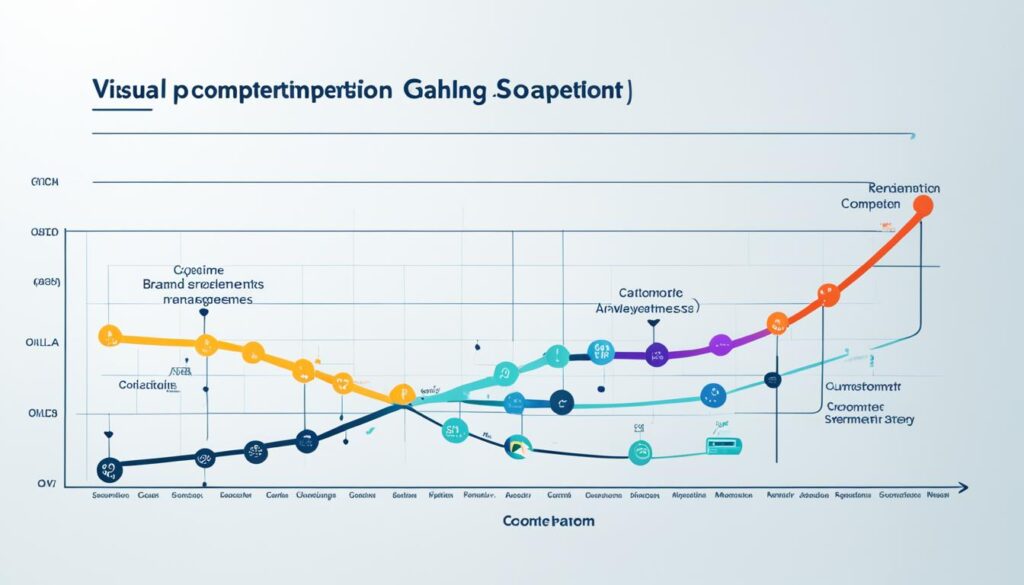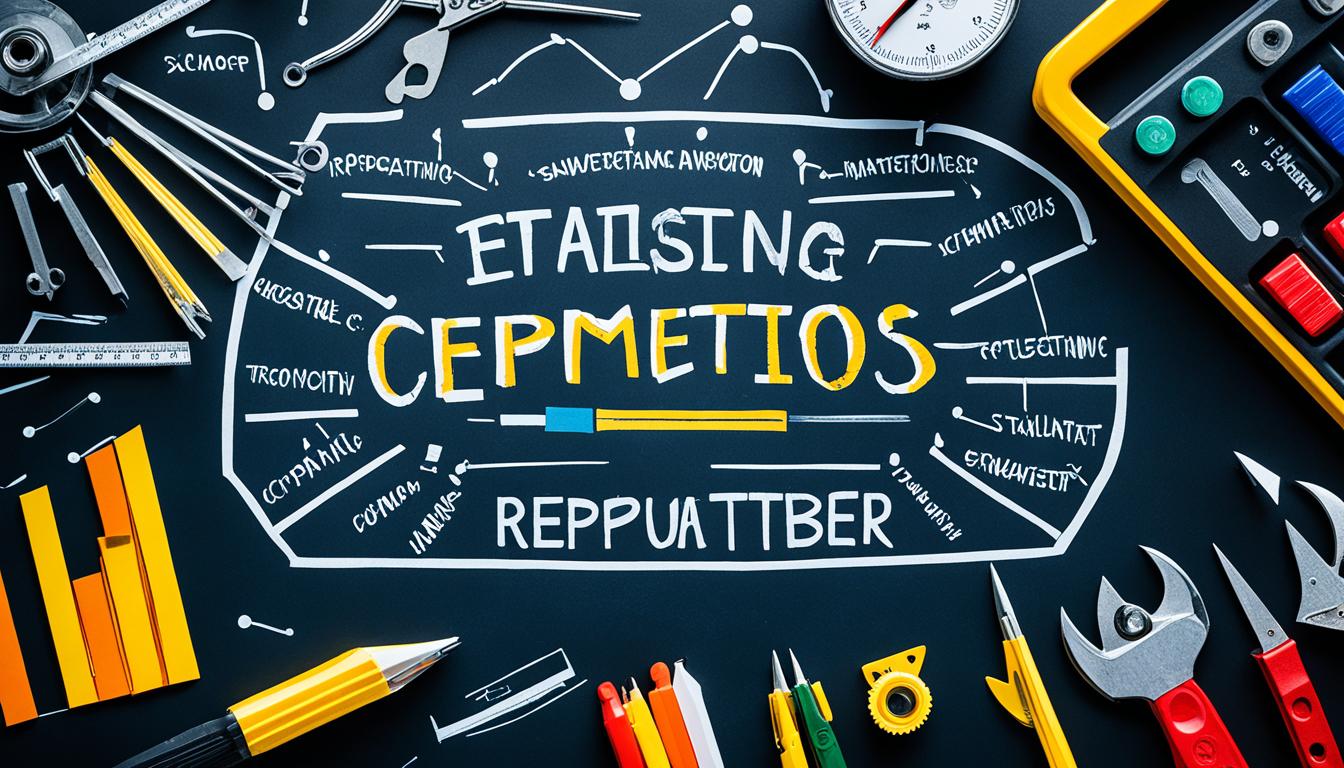Do you watch your rivals’ brand image online? It’s not enough to guard your own image now. Today’s competitive scene requires watching and reacting to competitors’ reputations. This keeps your business ahead.
Studying the competition is key. It lets you see what others in your field are up to. This knowledge helps you make your company better and stand out1. Understanding the market and spotting new chances is important for any business wanting to lead the pack1.
Competitive analysis means looking at all types of competitors. This includes both direct and indirect ones, plus alternatives1. By comparing what they do well, like pricing and marketing, with your own efforts, you get a clear picture. This way, you can tweak your strategy for better results2.
Looking at rivals regularly helps nearly 70% of companies find new growth paths. It lets them spot market voids, come up with fresh products, and see what’s trending3. The key reasons to keep an eye on competitors are to find what makes you stand out, pinpoint their strengths, set goals, and figure out your audience3.
Tools such as Sprout Social offer insights into your competition’s digital activities. This includes their posts, reviews, and search rankings. Taking advantage of this info can boost your own image and sales3.
Key Takeaways
- Conduct a full competitive analysis at least once a year to stay informed of competitors’ actions and your own market standing
- Analyze direct competitors, secondary/indirect competitors, and substitute competitors
- Compare your products and services to competitors in terms of pricing, geographic reach, promotional tactics, and more
- Identify your competitive advantage and areas for improvement by evaluating competitors’ strengths and weaknesses
- Leverage real-time insights from social media, review sites, and local search rankings to build trust and enhance your brand equity
The Importance of Competitive Analysis
In today’s ever-changing business world, doing a strong competitive analysis is crucial. It helps companies stand out. By looking closely at rivals, companies can spot areas where they can shine. They can also keep up with what’s popular and find chances to grow4. A recent study found that 82% of companies think this kind of analysis is key to long-term success4.
This analysis lets companies make smart choices about products, how they market them, and where to use resources. Checking out what competitors do online has helped 67% of companies improve how they market4. It lets them see what makes them different, learn from competitors’ strengths, and set goals to attract more customers3.
Going to industry events, like trade shows, is a great move for 73% of companies. It gives them a look at what competitors are up to. Plus, 58% of those who track competitors well see their market share grow4. This means they can find new opportunities, offer unique products and services, keep up with trends, and market smarter3.
When businesses invest in experts for competitive analysis, most of them find new insights into what their rivals are doing. This deep dive helps them make better decisions and plans. It’s noted for improving their strategies in 76% of cases4.
Companies that check out the competition regularly are 85% more likely to come up with new, exciting products and services4.
To do a solid competitive analysis, companies should take some crucial steps3:
- Identify and list all competitors
- Figure out where each competitor stands in the market
- Compare and measure these key competitors
If companies integrate competitor analysis well into their plans, they can be 63% more ready for competitive moves and market shifts4. This helps them win trust with customers, keep track of what’s being said about them online, and look good in the fast-paced digital world.
Monitoring Competitor Reputation
Today, keeping an eye on your competition’s image is key to doing well and looking good. By watching what they do online, we can learn a lot about their plans and how they treat customers3. This gives us ideas on how to do better and catch the eye of the people we want to impress.

How do we keep track? One smart way is social listening. We use special tools to follow our rivals on social media. Then, we figure out what they’re doing right and how people feel about it5. This shows us where we can step up, on social media, and connect more with our fans.
Don’t forget online reviews and what customers say. Good reviews tell us what our rivals shine at. Bad reviews point out where we need to do better6. This way, we’re always updating our products to be the best they can be, by knowing what people think of our competition.
“Reputation monitoring is not about copying competitors, but rather learning from their successes and failures to enhance our own brand.”
Reading news about them and the industry also helps. We find out about their latest moves and where they’re heading. This lets us find ways to stand out and be the leader that others look up to.
To keep up with our rivals, we should:
- Get alerts for news about them and important words
- Check out their websites, blogs, and ads often
- Keep an eye on their social media and join in on discussions
- Read their customer reviews and handle any issues that pop up
- Know what’s new in the industry and who the new competitors are
Following these steps helps us be on top and shape a positive, standout image. It’s not about doing what they do. It’s about using their lessons to do better for our customers and our place in the market.
Assessing Competitor Strengths and Weaknesses
In the current market, knowing our competition’s strengths and weaknesses is key to doing well. We look at what they do, how they place themselves, and what people think3. We use info from social media, the news, and their websites3.

The SWOT analysis is great for this. It looks at the competition’s strong points, weak spots, chances, and threats. Seeing where they succeed teaches us to improve. And spotting their flaws helps us stand out3.
We measure our competitors using the “four Ps” of marketing: Product, Pricing, Place, and Promotion17. But we also think about customer service, how they’re seen, what they do better, and how they run things inside7. We rate them from 1 to 10 in different areas to see how we can do better17.
| Competitor | Strengths | Weaknesses | Reputation Score |
|---|---|---|---|
| Competitor A | Extensive product range, strong brand loyalty | Higher prices, limited online presence | 8 |
| Competitor B | Innovative marketing campaigns, responsive customer service | Inconsistent product quality, low engagement rates | 7 |
| Competitor C | Competitive pricing, wide distribution network | Outdated website, negative customer reviews | 6 |
Studying the competition’s pros and cons shows us what people like and helps us find our edge1. Checking reviews and social media gives us an idea of how they’re viewed. This way, we can fix problems or meet needs if we see any3.
This work should always be going on and not done just once3. A full check once a year is a sound idea, with quick updates every few months1. Keeping an eye on our rivals and changing what we do accordingly keeps us ahead and well thought of online.
Developing Strategies to Address Reputation Challenges

Today, in a competitive market, companies must tackle reputation hurdles head-on. They need to use sentiment analysis and competitor analysis for insight. This helps them see how people view their brand and spot market gaps8.
Beating the competition requires a focus on top-notch products or services. Providing amazing customer experiences is key8. It’s vital to respond fast to all feedback to earn and keep customer trust9. Also, sharing good reviews and stories could draw in potential customers9.
Keeping an eye on online reviews is essential to know what customers think9. Tools like QuestionPro CX Reputation and others help in this area8. Being active on social media also plays a big part in managing reputation9.
Bad brand reviews can erode trust, making customers look elsewhere. Speedy responses to negatives help stop further damage8.
Creating standout content can make your reputation stronger and more visible9. Companies, like those in financial services, can use LinkedIn analytics. This helps spot trends and create content that really answers customer needs.
Checking out how competitors are seen can show where you can do better9. With a good reputation analysis, your business learns how it stacks up. This can guide you in crafting strategies that uplift your business reputation.
- Conduct sentiment analysis to check out the love and dislike levels in online talk about you8
- Make plans to deal with both bad and fake reviews and keep your brand shining8
- Boost customer experience by studying their interactions and using the findings to make smarter moves9
- Establish a top-notch team culture that enhances customer care9
By putting these moves into action, companies can face their reputation woes. This won’t just build a good name in the competitive market. It also helps in understanding what customers want, boosting sales and marketing success. This gives a real leg up in the market89.
Leveraging Competitor Analysis for Reputation Management
Studying our competition helps us find our place in the market. This analysis shows us what they do well and where they lack. It also reveals opportunities we can take advantage of, like unmet customer needs and overlooked marketing methods.

We track our rivals’ online reputation with tools such as Hootsuite. These tools let us see how much our brand is talked about against others. Knowing what topics are hot can guide our messaging, boosting our own reputation.
SWOT and PESTLE analyses help us see our standing versus competitors. SWOT looks into our internal aspects, while PESTLE checks outside factors. This helps us address any factors influencing our reputation or positioning.
A strong brand not only wins over customers but also partners and top talent10. It can cut down on getting new customers’ costs and increases loyalty. This can lead to customers being willing to pay more for our products11.
We do surveys and check online buzz to understand our brand’s reputation better. This includes gauging how satisfied and loyal customers are. Monitoring helps us keep tabs on what people say about us online.
- Emphasize our unique value proposition
- Celebrate successes and share positive testimonials and case studies
- Engage with our community and build strong relationships
- Continuously innovate our products, services, and processes
Using competitor analysis to shape our reputation is key. It doesn’t just guard our brand’s image but sets us ahead in the market. A good reputation builds trust, raises our brand standing, and supports lasting success1011.
Conclusion
In today’s world, every business needs to know what their competitors are up to. They must look closely at the market, prices, and strengths and weaknesses. This lets them see how they stack up in the industry1213.
Companies also need to watch what people are saying about their competitors. This means social media, reviews, and news articles. It gives them a real-time view of what customers think and how brands are seen14.
To do better than rivals, a business should stand out in the market. They can do this by offering great products and service. They should also find spots in the market that no one else has reached yet. Using social media tools like Sprout Social can help them understand what customers want from both their brand and its competitors12.
Sharing good reviews, talking to happy customers online, and getting support from influencers can enhance a company’s reputation14. This strategy helps spread positive stories about the brand. It also builds trust with their audience. Thus, businesses can do well even in a tough market by learning a lot about their competitors.
FAQ
What is the purpose of a competitive analysis?
Why is competitive analysis vital for businesses?
How can social media monitoring help with competitor research?
What is competitive intelligence, and how does it help businesses?
How can businesses differentiate themselves in a competitive market?
What are the benefits of using social listening tools for competitor analysis?
How does competitor analysis contribute to reputation management?
Source Links
- https://www.bdc.ca/en/articles-tools/marketing-sales-export/marketing/how-evaluate-competition
- https://www.semrush.com/blog/competitive-analysis/
- https://blog.hubspot.com/marketing/competitive-analysis-kit
- https://campuspress.yale.edu/ledger/why-businesses-should-study-their-competitors/
- https://sproutsocial.com/insights/competitor-analysis-tools/
- https://rizereviews.com/how-to-analyze-and-outrank-your-competitors-online-reputation-and-star-ratings/
- https://www.uschamber.com/co/start/strategy/assessing-competitors-strengths-and-weaknesses
- https://www.questionpro.com/blog/reputation-management-strategy/
- https://www.determ.com/blog/reputation-management-10-best-practices/
- https://www.linkedin.com/advice/0/how-can-you-identify-potential-risks-your-reputation-through
- https://www.codeglo.com/blog/how-to-leverage-reputation-management-for-brand-growth-2/
- https://venngage.com/blog/competitor-analysis-template/
- https://medium.com/@theakpobomeejiro/understanding-competitive-analysis-5c7de68a67a1
- https://konnectinsights.com/blogs/reputation-analysis/

